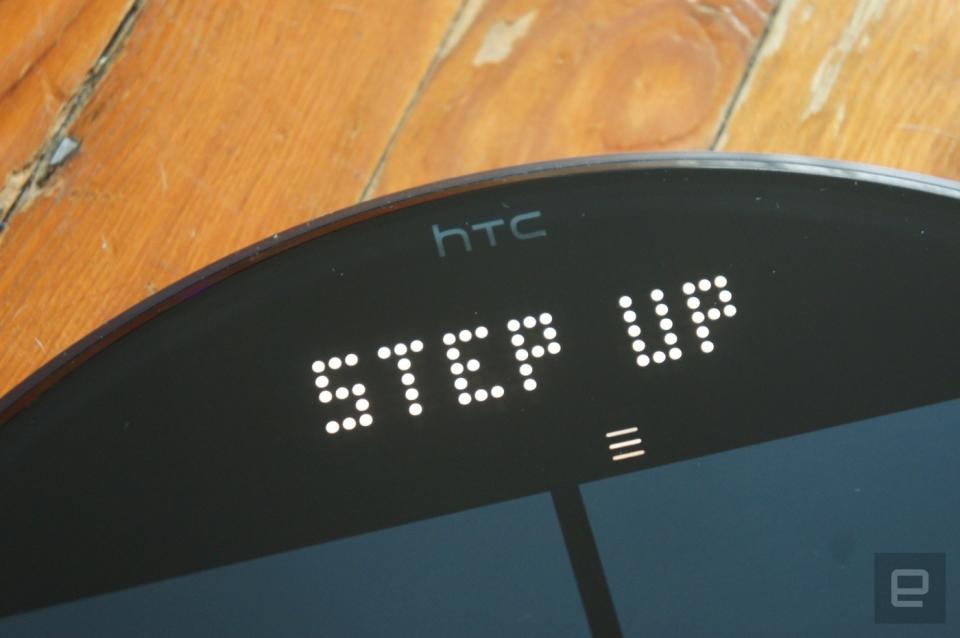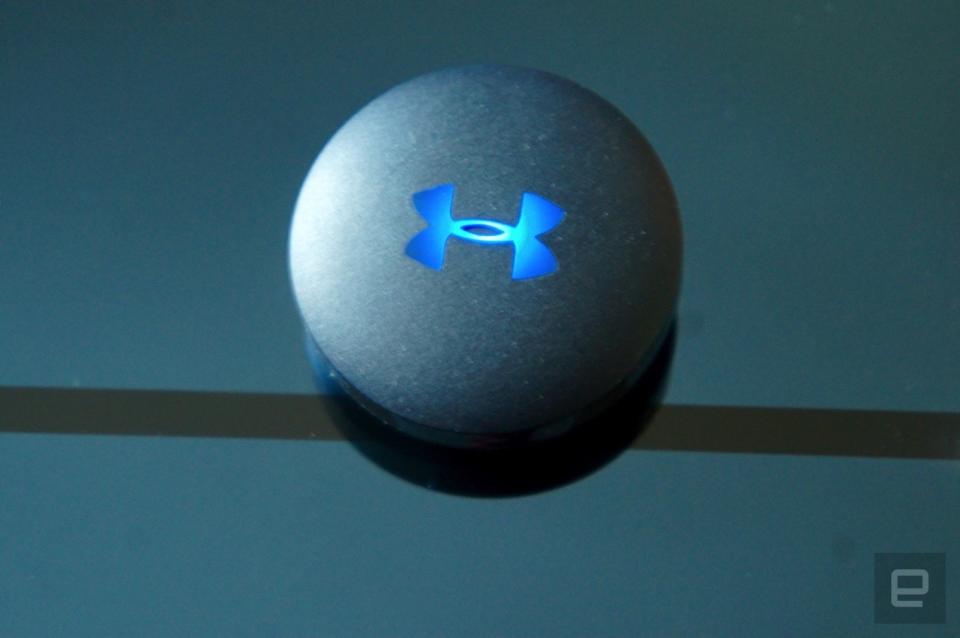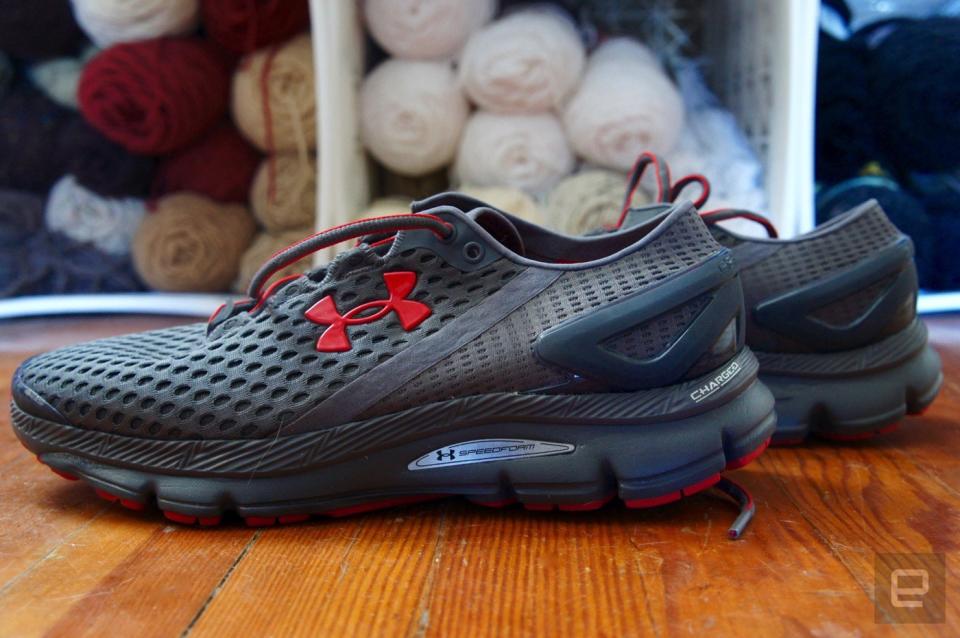For Under Armour, health tracking is more than a wristband
To get the most out of the company's new fitness line, you'll need to buy all the things.

Under Armour's pitch got me excited. Rather than dropping another fitness tracker on the world, the company had a vision. An ecosystem more robust than the competition and geared toward athletes, not just people looking for a pedometer. Sure, there's a wearable, the UA Band, but that's just one small part of the equation. There's also a WiFi scale, a heart-rate monitor, headphones and even connected shoes. Plus a raft of apps like Endomondo, MyFitnessPal and the hub for it all, Under Armour Record. It's a world of apps, gadgets and services that are supposed to work together to make a slimmer, faster and more motivated me.
A little more than a month into immersing myself in that world, I've found that the truth doesn't quite match those lofty ambitions.
For one, the Under Armour Band, while a solid first entry into the fitness-tracker scene, is somewhat uninspired. It's a simple black bracelet with some design flourishes courtesy of its partner in crime, HTC, that's made from decent-feeling materials. But it's definitely on the bulkier side: more Nike FuelBand than Jawbone Up. Basically, it's hefty enough that wearing it with a watch is a little clunky.
The swipe-and-tap interface is intuitive, but occasionally frustrating when it fails to respond to your touch. And while the step counter is reasonably accurate, it (like most wrist-worn monitors) struggles with sleep tracking. I was able to roll over, sit awake in bed reading on my phone for 15 minutes, get up, shower and shave, and the Band would still think I was asleep. It had a similar problem with idle notifications. If you don't move around enough, the Band will vibrate to nudge you to get off your ass. Unfortunately, it would often go off right as I was sitting down after standing around the kitchen making dinner or after making a trip to the office vending machine.

The list of features kinda goes on like that: They're good, but not great. For every positive there's an equally important negative. What you're left with is a $180 band that's a fine investment if you're already locked into the Under Armour ecosystem. The problem is, few people are locked into that right now. And the price of entry into Jawbone's and Fitbit's platforms is much lower. The Fitbit Zip is only $60, and you don't even need a wearable for Jawbone, just the free Up app. (At least in theory; I've never gotten it to work.) So it's hard to see the UA Band as the gateway drug that Under Armour was hoping for.
Thankfully, outside of the activity tracker, the lineup is a little more interesting. WiFi smart scales are nothing new, but Under Armour and HTC's take is attractive and smart. It's round and black, with a glass top and red accents underneath, like the Band. It serves up weight and body fat and can even let you know when you've reached your goal weight and congratulate you. Measuring weight and body fat is nothing unique, but the congratulatory messages add a little personality. During the unveiling, Under Armour reps talked about a future where they could serve up other messages and advice to the scale when you step on in the morning. Maybe you ate too much the day before and it's showing—the scale could tell you to take it easy on the doughnuts before you head to work.

Unfortunately, right now that's just a pipe dream. In fact, Under Armour can't even seem to get the goal-weight feature right. Literally every time I step on the scale, it tells me my goal is achieved, even though I've told the app several times that my target weight is a good 10 to 15 pounds lower.
The scale also struggled with multi-user support. While it was easily able to distinguish between me and my wife, the software relies too much on your weight as an identifying feature. A friend popped by a few weeks back and stepped on the scale while he was over. All of a sudden I got an alert that I had a new weigh-in. Turns out he weighs about as much as I do, and the scale thought he was me. To avoid those mix-ups, you need to manually choose a profile by pressing on the scale to wake it up, then tap on the right side to select the correct user.
And, like most digital scales, it's a bit finicky. If the floor isn't exactly level or if you put it on a carpet, you can throw off the accuracy. In fact, I could step off the scale and step right back on it and see a difference of up to five pounds in one spot with a slightly warped floorboard.
The list of features kinda goes on like that: They're good, but not great.
I won't spend too much time on the rest of the gadget pile. The heart-rate monitor is a heart-rate monitor. There's nothing to report outside of some trouble I had pairing it over Bluetooth. The same goes for the headphones: Once you've used one pair of premium fitness-focused bluetooth 'buds, you've used them all. These happen to be pretty solid, though they're definitely not designed for those with smaller ears. The smallest set of tips in the box only barely fit in my average-sized ears—my wife was SOL.
The other big part of the equation is the apps. In particular, the reworked Record application is excellent. Sure, connecting some of the devices, like the heart-rate monitor, can be a bit of a pain in the ass, but the app does deliver on some of the lofty promises. For one, it serves as a central hub for all your fitness and health data in a way that few other apps can match. It pulls in steps, sleep and exercise from the UA Band, weight and body fat from the scale, and you can do simple nutrition tracking, where you have a choice between light, medium or heavy calorie consumption.

But that's really just scratching the surface, because the app also ties into MyFitnessPal. If you do hardcore calorie counting (which this app got me back into), that's reflected in Record. Use Endomondo or MapMyRun to track a jog and it'll show up in the application too. And those apps work with the heart-rate monitor included in the Health Box, which means your peak and average heart rate will show up, giving you even more data to work from. It's almost enough to pry me out of RunKeeper's relentless grip (if not for the fact that I just paid for a year of RunKeeper Go in October).
It's almost enough to pry me out of RunKeeper's relentless grip.
Armed with all of this info, Record is supposed to make suggestions for improving your well-being. Do you need to take an extra day to recover from that long run? Record should tell you. Are you eating too much to get down to your goal weight? You can expect advice on your caloric intake. Unfortunately, I never saw any of these notifications. Now, to be fair, it's been a bad month for me healthwise. Between the holidays, my birthday (which is the week before Christmas), the launch of Engadget's redesign, and CES, I've had little time for the gym.
One feature that does help, however, is the "how do you feel" rating on the app's home screen. It's just a slider with a rating of 1 through 10, the idea being that each day you rate how you're feeling. Obviously, this is a completely subjective thing, and you can leave detailed notes if you want, but it does actually help identify trends. Many of them are obvious: The more I exercise, the better I sleep. Some are slightly more surprising: More than seven hours of sleep and I feel like garbage the next morning; my sweet spot is apparently between six and seven hours.

The one piece of the new fitness lineup that I haven't had the chance to try is the Record-equipped SpeedForm Gemini 2 sneakers. They're running shoes that connect to MapMyRun and track distance, speed, pace, etc. In fact, you don't even need to have your phone on you. If you go out for a run, the shoes will automatically sync all that data to the app next time they're in range. Unfortunately, the beta version of the app only just hit Android this week, and I've been battling a cold. So I've yet to take them for a test run.
It's hard not to applaud Under Armour's ambition. Has the company built a seamless ecosystem that goes beyond simple activity tracking? Absolutely not. But it's gotten closer than many of its competitors. There's a lot of moving parts, between the Band, the scale and countless apps (nine, by my last count), so it's not surprising that there are a lot of bugs to work out. If nothing else, these tools have helped highlight how unhealthy I can be. Now if I actually fix that, then I'd call Under Armour's efforts a success.

















